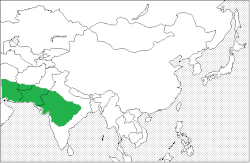Chinkara
Species of gazelle From Wikipedia, the free encyclopedia
The chinkara (Gazella bennettii), also known as the Indian gazelle, is a gazelle species native to India, Iran, Afghanistan and Pakistan.[1]
| Chinkara | |
|---|---|
 | |
| Chinkara in Thar Desert, Rajasthan | |
| Scientific classification | |
| Domain: | Eukaryota |
| Kingdom: | Animalia |
| Phylum: | Chordata |
| Class: | Mammalia |
| Order: | Artiodactyla |
| Family: | Bovidae |
| Subfamily: | Antilopinae |
| Tribe: | Antilopini |
| Genus: | Gazella |
| Species: | G. bennettii[2] |
| Binomial name | |
| Gazella bennettii[2] (Sykes, 1831) | |
 | |
| Distribution map of chinkara | |
Taxonomy
Summarize
Perspective
The following six subspecies are considered valid:[2]
- Deccan chinkara (G. b. bennettii) (Sykes 1831) – ranges from South India, from the Ganges Valley (east to the borders of West Bengal) south at least to Hyderabad, Andhra Pradesh, Deccan Plateau;
- Gujarat chinkara (G. b. christii) (Blyth, 1842) – ranges from the desert lowlands of Pakistan, western India, Rann of Kutch, Kathiawar, Saurastra region and as far east of Ahmedabad district in Gujarat;
- Kennion gazelle, eastern jebeer gazelle or Baluchistan gazelle (G. b. fuscifrons) (Blanford, 1873) – occurs in eastern Iran, (southeast and along the Makran coast, Sistan and Baluchistan) southern Afghanistan, Pakistan, Balochistan Province to Sindh and northwestern India, Rajasthan, also the darkest subspecies;
- Bushehr gazelle (G. b. karamii) (Groves, 1993) – ranges in southwestern Iran, restricted near Bushehr, also the smallest subspecies;[3]
- Jebeer gazelle, western jebeer gazelle or Shikari gazelle (G. b. shikarii) (Groves, 1993) – Lives in northeastern Iran, north and west-central districts (Touran, west to Tehran and southwest to Shiraz County and beyond), also the palest subspecies;[3]
- Salt Range gazelle (G. b. salinarum) (Groves, 2003) – ranges in Pakistan, Punjab region and east as far as Delhi, Indian Punjab, Haryana in northwest India, salt range;[4]
Characteristics
It stands at 65 cm (26 in) tall and weighs about 23 kg (51 lb). It has a reddish-buff summer coat with smooth, glossy fur. In winter, the white belly and throat fur is in greater contrast. The sides of the face have dark chestnut stripes from the corner of the eye to the muzzle, bordered by white stripes. Chinkara have straight horns with prominent rings which reach over 39 cm (15 in). Both males and females have horn although females have shorter horns.[5][6]


Distribution and habitat
Chinkara live in arid plains and hills, deserts, dry scrub and light forests. They inhabit more than 80 protected areas in India. In Pakistan, they range up to elevations of 1,500 m (4,900 ft). In Iran, their largest population is the Kavir National Park.[7]
In 2001, the Indian chinkara population was estimated at 100,000 with 80,000 living in the Thar Desert. The population in Pakistan is scattered, and has been severely reduced by hunting. Also in Iran, the population is fragmented. In Afghanistan, chinkaras are probably very rare.[7]

Behaviour and Ecology

Chinkara are swift and agile. Chinkara have nocturnal feeding habits, with most feeding activity during evening and night. They are browsers and consume leaves and grasses. They are observed alone or in groups of three, including mother and offspring. Sometimes groups of 8 to 10 individuals are observed. Chinkra are polygamous. Males are territorial and protect their territory. There are two breeding seasons in the year, one at the end of the rainy season and another at the end of spring. Chinkara have a gestation period of 5 to 5.5 months and females give birth to one offspring and sometimes twins who stay with their mother for 12 months.[6]
Chinkaras are preyed upon by Indian leopards, Bengal tigers, Asiatic lions and dholes. The chinkara was a common prey of the Asiatic cheetah in Iran. Outside protected areas they may be attacked by pariah dogs, and both Indian wolves and golden jackals are also known to hunt them.[6]
Threats
The chinkara is threatened by extensive hunting for meat and trophies in Afghanistan, Iran and Pakistan. Other threats include habitat loss due to agricultural and industrial expansion. The status in these countries is unclear. Around 1,300 individuals occur in Iran. In 2001, the chinkara population in India was estimated at over 100,000 individuals, of which nearly 80,000 occurred in the Thar desert. However, the population has declined since then. The chinkara is listed as least concern on the IUCN Red List.[1]
In 1993, a controversy erupted when the Government of Gujarat issued a decree to denotify the Narayan Sarovar Sanctuary, that contains a small population of chinkara, to allow mining of lignite, limestone, bentonite and bauxite inside the sanctuary. This was, however, rejected by the Gujarat High Court, and the sanctuary was restored to its earlier limits.[8][9]
Conservation
The chinkara is protected in Iran and Pakistan.[1] It occurs in over 80 protected areas in India.[8] In January 2016, the Government of Karnataka issued a notification to establish a sanctuary especially for chinkara in the Yadahalli village in the Bagalkot district of the state. This region shelters a major population of chinkara.[10] The Karnataka Government also notified the Bukkapatna Chinkara Wildlife Sanctuary in Tumakuru district in May 2019.[11]
See also
References
External links
Wikiwand - on
Seamless Wikipedia browsing. On steroids.

